[Ebook Việt hóa] The Unexpected Houseplant: 220 Extraordinary Choices for Every Spot in Your Home, Ngành Pinophyta - Ngành thông
[Ebook Việt Hoá] The Unexpected Houseplant: Conifers (ngành Pinophyta, ngành Thông)
- Nguồn: [Ebook] The Unexpected Houseplant: 220 Extraordinary Choices for Every Spot in Your Home –
- Biên tập: Dũng Cá Xinh (Tháng 02/2022)
- Dịch: Vui Nguyễn
English
CONIFERS
OUTDOORS THE LEAVES are ablaze with color. But every day, another tree or shrub goes naked. And every morning, I wake up to the squawking of Canada geese hysterically announcing their takeoff, arrival, or intention of making yet another reconnaissance mission to check out the pond at my property’s farthest point. That’s not the only morning music—there’s also the reassuring hum of the furnace firing up to warn me that the path down to the goat barn will be slippery with frost when I venture out to do the morning chores. Sure enough, when I slip out of bed, find my slippers, and make my way through a hallway booby-trapped by mangled kitten toys, I look out the window to confirm what I suspected—it frosted again last night. Almost every houseplant I pad past seems grateful that it was chosen to be shepherded back into the fold. But sometimes I wonder about the conifers. Would they have preferred to remain outside? It’s one of those instances where I need them more than they need me.
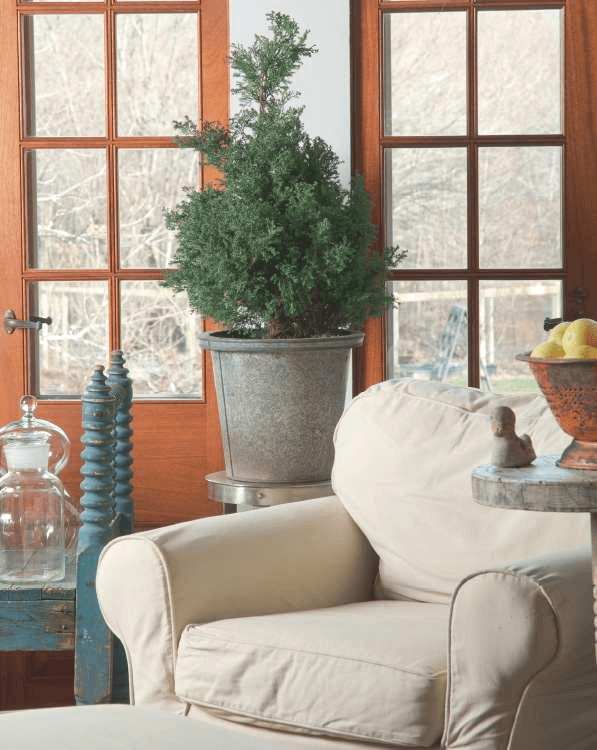
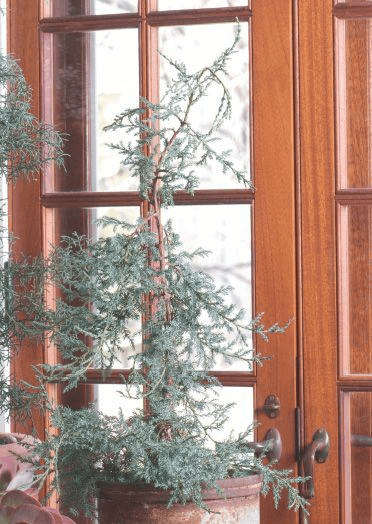
Mornings run like clockwork around here. Exercises, shower, breakfast. For breakfast, the traditional morning yogurt is consumed on the table surveying the entire Great Room from the far end of the converted barn. Most of the meal is spent shuffling aimlessly through the stack of magazines and newspapers on the table. But between the letters to the editor and the obituaries, I occasionally glance up. And when I do, the potted conifers come into my field of vision. There’s something infinitely comforting in that view. As much as conifers slip into the background outdoors, they stand out inside. A few years ago, I began framing my windows by bringing a few potted conifers indoors, and now they’ve become a fixture.
Originally, it was just a stopgap measure. On a whim, I bought Cupressus arizonica ‘Blue Ice’, and then discovered it is only marginally hardy in my unpredictable region. Rather than putting it in the ground, I placed it in a massive long tom–shaped container. Over the summer, I became rather fond of the blue-green fellow as it stood sentinel beside the front door. Meanwhile, it showed its grit by surmounting the challenges of low light thanks to the massive maple that shades the front of the house. Come fall, the obvious solution to the “what now?” quandary might have been to plant it and throw caution to the wind. Instead, I procrastinated. And procrastinated. When the window of safe transplanting opportunity outdoors slammed shut, it was marched indoors—with a little help from my (muscular) friends. And it changed my world. That started a whole spate of experimentation with conifers.
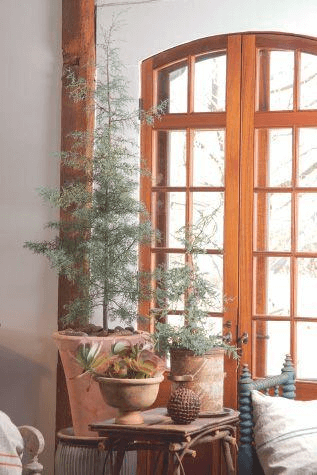
Next came a juniper, purchased at slashed prices at an autumn nursery sale. In the fall leaf-raking, bulb-planting rush, I failed to get it into the ground (are we noticing a trend here?). To be specific, it was Juniperus procumbens ‘Nana’, and I began to like the way it spread out at right angles from its nursery container, like a teased-out bouffant. So it was given an industrial metal cylinder container and brought inside. Chamaecyparis pisifera ‘Boulevard’ followed suit (by that time, the conifers no longer needed justification). Although the chamaecyparis gave the strongest silhouette and went furthest toward establishing the mood of a forest indoors, it was not the easiest conifer to care for inside. The juniper, on the other hand, never let out a whimper.
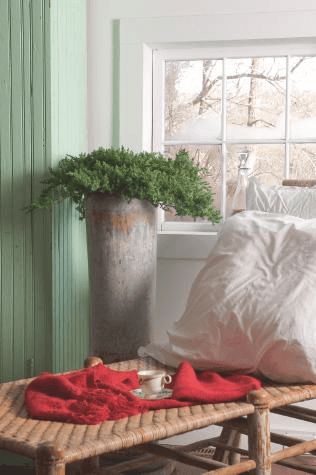
The critical secret to success with conifers lies in their containers. They demand something deep, with plenty of root room to plunge down, but also a sufficiently broad base so that the root ball isn’t cramped. You need to be able to water easily and effectively. The main cause of death for conifers inside is drying out because of lack of water. Problem is, they are not whiners; a conifer will rarely, if ever, wilt. So check the soil and water generously, keeping in mind that you are quenching a large mass of roots. Skip fertilizer. For the duration the conifers remain inside, they receive no nourishment beyond the compost in the organic soil where their roots are plunging.
Practically speaking, trees of any sort work best in the periphery of a room. Junipers, in particular, tend to be prickly (and can irritate the skin on some people), so you wouldn’t want to collide with one in the dark. Off the beaten track, they take the same position they usually assume outside: they’re the strong-and-silent types standing on the sidelines. It’s one of those delicious moments when design and necessity merge.
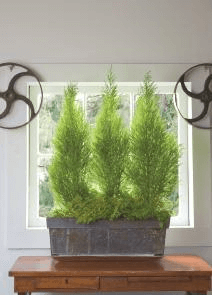
Plus, conifers need a light source. Mine dote on their eastern exposure and do just fine, even though the sun is not strong during the winter. Rather than placing them on the floor, I raise them up—they sit on an inverted antique rain barrel or straddle a metal stool. This keeps the wooden floor from harm. The elevation adds to their stature (and conifers make great exclamation points indoors), and the raised height puts them squarely in the window, delivering the dosage of light the foliage craves.
As soon as temperatures moderate sufficiently to keep their containers from cracking, out the conifers go. I don’t wait for danger of frost to pass entirely. At the maximum, they’re inside for five months. After that, they need the fresh air and I need the space to start seedlings.
- ALSO CALLED: false cypress, juniper
| FLOWERS | None |
| FOLIAGE | Lots of texture, can be golden or blue-green |
| OTHER ATTRIBUTES |
Great vertical elements in a home |
| SIZE | Tree size; groundcovering conifers are also apropos |
| EXPOSURE | Shady east or west; will survive in south |
| WATER REQUIREMENTS |
Lightly moist, do not allow to dry out |
| OPTIMUM NIGHTTIME TEMPERATURE |
50–55°F (10–12°C) |
| RATE OF GROWTH | Slow |
| SOIL TYPE | Rich, well-drained, humusy soil |
| FERTILIZING | I don’t fertilize mine |
| PROBLEMS | Mealy bugs, but that’s their only foe. |
Tiếng Việt
CÂY NGÀNH THÔNG (CONIFER)
Ở NGOÀI TRỜI, LÁ CÂY rực rỡ với nhiều màu sắc. Nhưng càng ngày, cây trồng và các cây bụi khác lại dần trần trụi. Và mỗi buổi sáng, tôi thức dậy với tiếng kêu cuồng nhiệt của những con ngỗng Canada, thông báo rằng chúng sắp cất cánh, sắp đến nơi hoặc có ý định thực hiện một nhiệm vụ do thám nào đó để kiếm xem có cái ao nào xa chỗ tôi nhất hay không. Đó không phải là bản nhạc duy nhất vào buổi sáng, còn có tiếng tí tách của bếp lò đang cháy, nó cảnh báo tôi rằng con đường dẫn xuống chuồng dê sẽ trơn trượt vì sương giá khi tôi mạo hiểm làm việc nhà vào mỗi buổi sáng. Chắc chắn rồi, khi tôi bước ra khỏi giường, tìm đôi dép và đi qua một hành lang chất đầy những món đồ chơi của những con mèo nghịch ngợm, tôi nhìn ra cửa sổ để xác nhận điều tôi nghi ngờ — đêm qua lại có tuyết rơi. Hầu như mọi cây trồng trong nhà mà tôi từng trồng đều có vẻ rất biết ơn tôi vì đã đưa chúng trở lại trong nhà. Nhưng đôi khi tôi băn khoăn về các loài cây lá kim. Chúng có muốn ở lại bên ngoài không? Đó là một trong những trường hợp tôi cần chúng hơn chúng cần tôi.


Một buổi sáng trôi qua rất nhanh. Tập thể dục, tắm rửa, ăn sáng. Đối với bữa sáng, tôi ăn sữa chua truyền thống trên chiếc bàn có thể quan sát toàn bộ căn phòng lớn từ phía xa. Hầu hết bữa ăn bị xáo trộn bởi các chồng tạp chí và giấy báo trên bàn. Tôi ngước nhìn lên giữa những bức thư gửi cho tòa soạn và những tờ cáo phó. Khi đó, những cây lá kim trong chậu lọt vào tầm mắt của tôi. Những cây lá kim bên ngoài lọt vào khung cửa sổ, chúng làm bừng sáng bên trong nhà. Một vài năm trước, tôi bắt đầu mang một vài cây lá kim trong chậu vào nhà và bây giờ chúng đã trở thành một vật cố định.
Ban đầu, nó chỉ là một biện pháp tạm thời. Trong một lần bất chợt, tôi đã mua Cupressus arizonica ‘Blue Ice’, và sau đó phát hiện ra rằng nó chỉ chịu được thời tiết hơi lạnh trong khu vực không thể đoán trước của tôi. Thay vì trồng trực tiếp xuống đất, tôi trồng nó trong một cái chậu to, dài khổng lồ. Trong suốt mùa hè, tôi trở nên thích thú đối với anh bạn có màu xanh lam đứng canh gác bên cạnh cửa trước này. Trong khi đó, nó thể hiện sự gan góc của mình bằng cách vượt qua những thách thức về ánh sáng do cây phong khổng lồ che bóng trước ngôi nhà. Thu sang, giải pháp rõ ràng cho vấn đề “bây giờ làm gì?” là trồng nó và giữ nó cẩn thận trước gió. Thay vào đó, tôi đã chần chừ. Và chần chừ. Khi cơ hội trồng chúng an toàn ngoài trời vụt mất, tôi mang nó vào trong nhà — với sự giúp đỡ từ những người bạn (cơ bắp) của tôi. Và nó đã thay đổi thế giới của tôi. Điều đó đã bắt đầu một loạt các thử nghiệm với loài cây lá kim này.

Tiếp đến là cây bách xù, được mua với giá vô cùng rẻ trong một đợt sale của vườn ươm mùa thu. Vào mùa thu lá đổ, tôi đã thất bại khi trồng nó xuống đất. Cụ thể, đây là Juniperus procumbens ‘Nana’, tôi bắt đầu thích cách tán lá vươn đều trong chậu chứa, nó giống như một mái tóc bồng bềnh. Vì vậy, tôi đã trồng nó trong một cái chậu kim loại công nghiệp hình trụ và đưa vào trong nhà. Chamaecyparis pisifera ‘Boulevard’ cũng theo sau đó. Mặc dù chamaecyparis cho nhiều bóng mát và phù hợp với việc tạo không gian khu rừng trong nhà nhất, nhưng nó không phải là loài dễ chăm sóc trong nhà. Ngược lại, cây bách xù lại chẳng bao giờ phàn nàn gì.

Bí quyết quan trọng để trồng thành công cây lá kim là nằm ở thùng chứa. Chúng cần một thứ gì đó sâu, có nhiều chỗ để rễ ăn sâu xuống, nhưng cũng cần có một nơi đủ đủ rộng để bóng rễ phát triển. Từ đó bạn có thể tưới nước dễ dàng và hiệu quả hơn. Nguyên nhân chính làm các cây lá kim trong nhà chết là khô héo vì thiếu nước. Vấn đề là, chúng không phải là loại cây hay than vãn; và cây tùng lại hiếm khi héo. Vì vậy, hãy kiểm tra đất và tưới nhiều nước, lưu ý rằng bạn đang tưới nước cho một khối lượng lớn rễ. Bỏ qua bước bón phân. Trong suốt thời gian cây lá kim sống trong nhà, chúng không nhận được chất dinh dưỡng nào ngoài phân trộn trong đất hữu cơ, nơi rễ của chúng đang đâm xuống.
Thực tế mà nói, loại cây nào cũng phát triển tốt nhất ở vùng ngoại vi của căn phòng. Đặc biệt, cây bách xù thường có gai (và có thể gây kích ứng da), vì vậy bạn sẽ không muốn chạm phải chúng trong bóng tối. Khi ở bên ngoài, chúng cũng thường hay được trồng ở những vị trí như thế: chúng là kiểu cây trồng luôn mạnh mẽ và im lặng đứng bên lề. Đó là một trong những khoảnh khắc tuyệt vời khi thiết kế và hợp nhất những thứ cần thiết.

Thêm vào đó, cây lá kim cần ánh sáng. Ánh nắng phía đông cũng rất ổn, mặc dù mặt trời không mạnh lắm vào mùa đông. Thay vì đặt chúng trên sàn nhà, tôi nâng chúng lên và đặt chúng trên các thùng chứa nước mưa cổ xưa hoặc một chiếc ghế đẩu kim loại. Điều này giúp sàn gỗ không bị hư hỏng. Độ cao này làm tăng thêm tầm vóc của chúng (và các loài cây lá kim có hình dạng giống như dấu chấm than sẽ xuất hiện trong nhà), và độ cao này cũng cung cấp ánh sáng mà chúng cần.
Ngay sau khi nhiệt độ đủ để giữ cho các thùng chứa không bị nứt, các cây lá kim sẽ biến mất. Tôi không đợi băng giá qua hoàn toàn. Chúng sẽ ở trong đó tối đa năm tháng. Sau đó, chúng cần không khí trong lành và tôi cần không gian để bắt đầu ươm cây con.
- CŨNG ĐƯỢC GỌI LÀ: cây bách sai, cây bách xù
| HOA | không có |
| LÁ | có nhiều kết cấu, có màu vàng hoặc xanh |
| THUỘC TÍNH KHÁC | là loại cây mọc thẳng tuyệt đẹp |
| KÍCH THƯỚC | cây gỗ, cây bụi |
| ÁNH SÁNG | bóng ở phía đông hoặc tây; phía nam |
| YÊU CẦU VỀ NƯỚC | ẩm nhẹ, không được để đất khô |
| NHIỆT ĐỘ TỐI ƯU BAN ĐÊM | 50–55°F (10–12°C) |
| TỐC ĐỘ PHÁT TRIỂN | chậm |
| LOẠI ĐẤT | đất mùn màu mỡ, thoát nước tốt |
| BÓN PHÂN | không bón phân |
| VẤN ĐỀ | rệp sáp là kẻ thù duy nhất |
![[Ebook Việt Hoá] The Unexpected Houseplant: Conifers (ngành Pinophyta, ngành Thông) [Ebook Việt Hoá] The Unexpected Houseplant: Conifers (ngành Pinophyta, ngành Thông)](https://vn1.vdrive.vn/codai.net/2021/02/ebook-viet-hoa-220-lua-chon-cay-canh-trong-nha-06-conifers.jpg)


